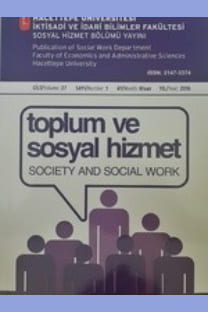Çocuğa Yönelik Cinsel İstismar Deneyiminin Mikro Ve Mezzo Sistemler Açısından İncelenmesi
Cinsel istismar, mikro sistem, mezzo sistem
Investigatıon of Sexual Abuse Experience in Children with Micro and Mezzo Systems
Sexual abuse, micro system, mezzo system,
___
- Andreae, D. (2011). General systems theory: Contributions to social work theory and practice. Social Work Treatment: Interlocking Theoretical Approaches, 242-254.
- Bagley, C., Wood, M. and Young, L. (1994). Victim to abuser: Mental health and behavioral sequels of child sexual abuse in a community survey of young adult males. Child Abuse and Neglect, 18(8), 683-697.
- Belsky J, Straton P. An ecological analysis of the etiology of child maltreatment. In Browne K, Hanks H, Stratton P, Hamilton C. (Eds.), Early prediction and prevention of child abuse. A Handbook, England: John Wiley and Sons. 2000.
- Cohen, J. A. and Mannarino, A. P. (1996). Factors that mediate treatment outcome of sexually abused preschool children. Journal of the American Academy of Child and Adolescent Psychiatry, 35(10), 1402-1410.
- Creswell, J. W. (2007). Five qualitative approaches to inquiry. Qualitative inquiry and research design: Choosing among five approaches. Thousand Oaks, CA: Sage.
- Deblinger, E., Steer, R. and Lippman, J. (1999). Two year follow up study of cognitive behavioral therapy for sexually abused children suffering post-traumatic stress symptoms. Child Abuse and Neglect, 23(12), 1371–1378.
- Drum, R. D., Pittman, S. and Perry, S. (2004). Social work interventions in refugee camps. Journal of Social Service Research, 30(2), 67-92.
- Elliott, A. N. and Carnes, C. N. (2001). Reactions of nonoffending parents to the sexual abuse of their child: A review of the literatüre. Child Maltreatment, 6(4), 314-331.
- Finkelhor, D. and Browne, A. (1985). The traumatic impact of child sexual abuse: A conceptualization. American Journal of Orthopsychiatry, 55(4), 530-541.
- Finkelhor, D., Hotaling, G., Lewis, I. and Smith, C. (1990). Sexual abuse in a national survey of adult men and women: Prevalence, characteristics, and risk factors. Child Abuse and Neglect, 14(1), 19-28.
- Friedrich, J., Fisher, C., Dittner, R., Acton, L. B. and Butler, J. (2001). Child sexual behavior inventory: Normative, psychiatric, and sexual abuse comparisons. Child Maltreatment 6(1), 37–49.
- Garbarino J, Kostelny K. Child maltreatment as a community problem. Child Abuse and Neglect, 1992; 16(4), 455-464.
- Hornor, G. (2010). Child sexual abuse: Consequences and implications. Journal of Pediatric Health Care, 24(6), 358-364.
- Joshi PT, Daniolos PT, Salpekar JA. (2010) Child abuse and neglect In: Dulcan MK, (ed). Dulcan's textbook of child and adolescent psychiatry. First ed. Arlington American Psychiatric Publish,479-494.
- Manion, I. G., McIntyre, J., Firestone, P., Ligezinska, M., Ensom, R. and Wells, G. (1996). Secondary traumatization in parents following the disclosure of extrafamilial child sexual abuse: Initial effects. Child Abuse and Neglect, 20(11), 1095-1109.
- Marshall, C. and Rossman, G. B. (2011). Designing qualitative research. Thousand Oaks, CA: Sage.
- Oates, R. K., Tebbutt, J., Swanston, H., Lynch, D. L. and O’Toole, B. I. (1998). Prior childhood sexual abuse in mothers of sexually abused children. Child Abuse and Neglect, 22(11), 1113-1118.
- Paslı, F. (2017). Cinsel istismara uğrayan çocukların ekolojik sistem yaklaşımı açısından incelenmesi. Gazi Üniversitesi Sağlık Bilimleri Dergisi, 2(2):39-53.
- Polat, O. (2007). Tüm boyutlarıyla çocuk istismarı. Cilt 1, 1. Baskı, Ankara: Seçkin Yayıncılık.
- Putnam, F. (2003). Ten year research update review: child sexual abuse. Journal of the American Academy of Child and Adolescent Psychiatry, 42(3), 269-278.
- Stern, A. E., Lynch, D. L., Oates, R. K., O'Toole, B. I. and Cooney, G. (1995). Self esteem, depression, behaviour and family functioning in sexually abused children. Journal of Child Psychology and Psychiatry, 36(6), 1077-1089.
- Spencer N, Devereux E, Wallace A, Sundrum R, Shenoy M, Bacchus C. Logan S. Disabling conditions and registration for child abuse and neglect: a population-based study. Pediatrics, 2005; 116(3), 609-613.
- Summit, R. C. (1983). The child sexual abuse accomodation syndrome. Child Abuse and Neglect, 7(2), 177-193.
- Teater, B. (2014). An introduction to applying social work theories and methods. Ed. Karatay, A., 2nd Edition, UK: McGraw-Hill Education Open University Press.
- Veenema, T. G., Thornton, C. P. and Corley, A. (2015). The public health crisis of child sexual abuse in low and middle income countries: An integrative review of the literature. International Journal of Nursing Studies, 52(4), 864-881.
- Yolcuoğlu, İ. (2014). Bireylerle, Ailelerle, Gruplarla ve Toplumla Sosyal Hizmet. İstanbul, Nar Yayınevi.
- Zastrow, C. (2013). Sosyal Hizmete Giriş.1. Baskı, Ankara, Nika Yayınevi.
- ISSN: 2147-3374
- Yayın Aralığı: 4
- Başlangıç: 2000
- Yayıncı: Hacettepe Üniversitesi İktisadi ve İdari Bilimler Fakültesi
Sosyal Hizmet Uzmanları İçin Psikolojik Dayanıklılığın Önemi
Kuzey Kıbrıs Türk Cumhuriyeti’nde Sosyal Hizmetlerin Yapısı Ve İşleyişine Eleştirel Bir Bakış
Ayşe ÖZADA NAZIM, Mualla KÖSEOĞLU
Evsizlerin Sosyo-Demografik Özellikleri Ve Sokak Yaşam Deneyimleri: Antalya Örneği
Ayten KAYA KILIÇ, Hüsnünur ASLANTÜRK
Türkiye’de Yaşlı Yoksulluğu Sorununa Yönelik Bir Değerlendirme
Ebeveynlerin Gözünden Çocuk İstismarı: Metaforik Bir Çalışma
Rehberlik Öğretmenlerinin Okul Sosyal Hizmetine İhtiyaç Duydukları Sorun Alanlarının Belirlenmesi
EBEVEYNLERİN GÖZÜNDEN ÇOCUK İSTİSMARI: METAFORİK BİR ÇALIŞMA
TORUNLARINA BAKAN BÜYÜKANNELERİN DENEYİMLERİNE İLİŞKİN NİTEL BİR ARAŞTIRMA
